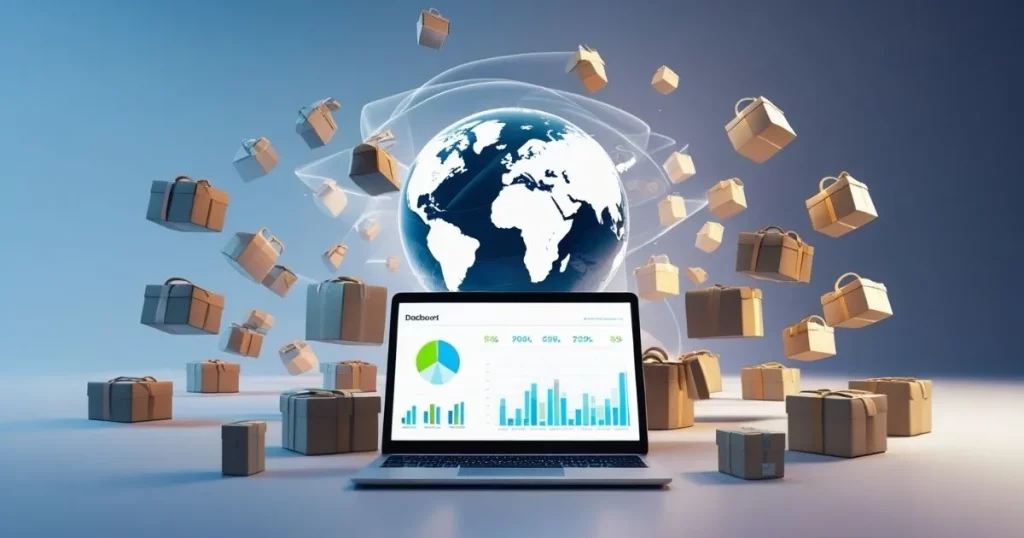Imagine this—you’re living in Thailand, surrounded by a thriving digital economy, and you notice something interesting. Every day, more and more people are shopping online, scrolling through Facebook, Instagram, and Lazada to find their next purchase. You see small businesses popping up everywhere, from handmade jewellery stores to boutique coffee brands, all making serious money online.
You start to wonder: What if I could do the same? Maybe you have a product idea, or you want to turn a passion into profit. But where do you even begin? What platform should you use? How do you handle payments, shipping, and marketing? The good news is that Thailand’s e-commerce scene is exploding, and there has never been a better time to start selling online.
In this guide, we’ll walk you through the exact steps to launch and scale a successful e-commerce business in Thailand. Whether you’re thinking about using Shopify Thailand, selling on Lazada, or building your own brand, we’ll cover everything from legal requirements to digital marketing strategies. Ready to turn your idea into a thriving online business? Let’s get started!
Why Thailand is a Hotspot for E-Commerce
Thailand’s e-commerce industry is growing at an unprecedented rate, making it one of the most promising markets in Southeast Asia. With millions of consumers shifting to online shopping and government policies supporting digital businesses, the opportunities for entrepreneurs are endless.
Growing Digital Economy
Thailand has over 50 million internet users, with mobile penetration exceeding 85% of the population. This means that nearly everyone has a smartphone and is actively engaging with online content. Mobile commerce, or m-commerce, is particularly dominant, with platforms like Facebook, Instagram, and TikTok serving as virtual shopping malls. With the rise of digital payments such as PromptPay, TrueMoney, and mobile banking, the online shopping experience is more seamless than ever.
Consumer Behaviour Shift
Thai consumers are highly active on social media, and social commerce plays a major role in purchasing decisions. Platforms like Lazada, Shopee, and Facebook Live Selling are driving sales, with influencers and live streamers playing a key role in e-commerce transactions. Additionally, the demand for convenience and fast delivery has made online shopping the preferred choice for many.
Government Support for E-Commerce
The Thai government actively promotes digital entrepreneurship through initiatives like the Thailand 4.0 policy, which encourages tech-driven businesses. Foreign investors and startups also benefit from BOI (Board of Investment) incentives, making Thailand an attractive market for e-commerce ventures.
With a booming digital economy, tech-savvy consumers, and strong government backing, now is the perfect time to launch an online business in Thailand.
Setting Up Your E-Commerce Business in Thailand

Before diving into Thailand’s thriving e-commerce market, you need to decide on the right business model. Your choice will impact everything—from startup costs to logistics and scalability. Let’s break down the key options.
Choosing the Right Business Model
1. Dropshipping: Low-Risk, Low Investment
Dropshipping allows you to sell products without holding inventory. You partner with suppliers who handle storage and shipping. This model is great for beginners with limited capital but can be challenging due to supplier reliability and lower profit margins.
2. Inventory-Based: Higher Control, Bigger Profits
If you want full control over branding and product quality, buying and storing inventory is the way to go. While it requires more upfront investment in stock and storage, it allows for higher profit margins and better customer experience.
3. Print-on-Demand: Customisation Without Inventory
For entrepreneurs interested in selling custom-designed products (t-shirts, mugs, phone cases), print-on-demand is a great option. You don’t need to hold stock—items are printed and shipped only when a customer places an order.
Selling on Marketplaces vs. Your Own Website
Marketplaces (Lazada, Shopee, TikTok Shop)
Pros:
✅ Instant traffic & visibility
✅ Built-in payment & logistics support
✅ Easier for beginners
Cons:
❌ High competition & platform fees
❌ Less control over branding
Own E-Commerce Website (Shopify Thailand, WooCommerce)
Pros:
✅ Full control over branding & pricing
✅ No marketplace commission fees
✅ Ability to build long-term customer relationships
Cons:
❌ Requires digital marketing efforts to drive traffic
❌ Higher upfront setup costs
Many successful sellers combine both strategies—leveraging marketplaces for visibility while building their own website for long-term growth. Up next, we’ll cover how to set up and launch your store effectively.
Building and Launching Your Online Store

Once you’ve chosen your business model, it’s time to build and launch your e-commerce store. A well-designed, mobile-friendly website with smooth payment and shipping options is key to success.
Website Setup Essentials
1. Choosing a Domain Name & Hosting
Your domain name should be short, memorable, and reflect your brand (e.g., BangkokFashion.com). For hosting, platforms like Shopify Thailand, WooCommerce, and Wix offer beginner-friendly solutions with built-in e-commerce features.
2. Designing a High-Converting Store
A professional, clean, and fast-loading website builds trust and improves sales. Here are key design tips:
✅ Use a simple layout – Avoid clutter and make navigation easy.
✅ High-quality images & videos – Show products in action.
✅ Fast-loading pages – Speed impacts conversions.
3. Mobile Optimisation is Crucial
With most Thai consumers shopping on their smartphones, ensure your store is 100% mobile-responsive. Test your site’s mobile experience to avoid slow loading times or difficult checkouts.
Payment Gateways & Logistics
1. Popular Payment Options in Thailand
Thailand has a unique digital payment landscape. Offering multiple payment options increases conversions.
- PromptPay – The most widely used instant bank transfer system.
- Credit & Debit Cards – Visa, Mastercard, and local banks.
- Cash on Delivery (COD) – Still preferred by many customers.
- E-Wallets – TrueMoney, Line Pay, and ShopeePay.
2. Reliable Shipping & Fulfilment Partners
Fast, affordable shipping builds customer trust. Popular logistics providers include:
🚚 Thailand Post – Affordable nationwide delivery.
🚚 Kerry Express – Fast, reliable service with COD options.
🚚 Flash Express & J&T Express – Competitive pricing and e-commerce integration.
With the right setup, your store will be ready to launch and start making sales. Next, we’ll explore marketing strategies to grow your business.
Marketing Strategies to Grow Your E-Commerce Business

Building a great online store is just the beginning—driving traffic and converting visitors into customers is where the real challenge begins. In Thailand’s competitive e-commerce space, smart marketing is key to success. Here’s how you can stand out and grow your business effectively.
Social Media Marketing
Thailand is a social media-first market, meaning platforms like Facebook, Instagram, and TikTok aren’t just for engagement—they’re direct sales channels.
✅ Leveraging Social Media for Sales
- Facebook & Instagram Shops – Set up in-app stores to make purchasing seamless.
- TikTok Shopping – Use viral short videos and trending challenges to drive sales.
- Facebook Groups & Line Communities – Engage with niche audiences for organic growth.
🎥 Live Selling & Influencer Marketing
Live selling is huge in Thailand. Hosting Facebook Live sales or partnering with Thai influencers can skyrocket conversions. Consider collaborating with micro-influencers (10k–50k followers) who have highly engaged audiences.
Search Engine Optimisation (SEO)
SEO helps your store get found organically on Google and other search engines.
🏆 Optimising Your Product Pages for Local SEO
- Use Thai-language keywords alongside English (e.g., “ซื้อรองเท้าออนไลน์” = “buy shoes online”).
- Optimise meta descriptions, URLs, and image alt-text for search visibility.
- Create valuable blog content related to your niche (e.g., “Best Yoga Mats in Thailand”).
💰 Using Google Ads to Drive Traffic
- Google Shopping Ads – Showcase products directly on Google search.
- Localised PPC Campaigns – Target Thai consumers using Thai-language ads.
Paid Advertising & Retargeting
Paid ads accelerate growth and put your brand in front of the right audience.
🚀 Facebook & Instagram Ads for E-Commerce Sales
- Use high-quality visuals & videos in your ad creatives.
- Test different formats like carousel ads, collection ads, and reels.
- Target Thai consumers based on interests, location, and online shopping behaviour.
🎯 Retargeting to Boost Conversions
- Facebook Pixel & Google Retargeting – Show ads to people who visited your store but didn’t buy.
- Cart Abandonment Emails – Send reminders to customers who left items in their cart.
Leveraging Marketplaces & Partnerships
Many successful e-commerce entrepreneurs in Thailand sell on both marketplaces and their own Shopify store.
🛍 Selling on Lazada & Shopee While Running Your Own Store
- Use marketplaces to acquire new customers and drive traffic to your website.
- Offer exclusive discounts on your own store to encourage repeat buyers.
🤝 Collaborating with Thai Influencers & Affiliates
- Set up an affiliate programme where influencers earn a commission for each sale.
- Partner with local YouTubers, bloggers, and Instagram pages to increase brand awareness.
By combining social media, SEO, paid ads, and marketplace strategies, you can scale your e-commerce business faster and dominate the Thai market. Up next, we’ll explore how to automate and scale your operations for long-term success.
Scaling Your E-Commerce Business in Thailand

Once your online store is generating consistent sales, the next step is scaling—growing your revenue while improving efficiency. This involves automating operations, expanding your product range, and building customer loyalty for long-term success.
1. Automating Operations for Efficiency
As your business grows, manual processes can slow you down. Automation helps you save time, reduce errors, and scale faster.
✅ Chatbots & AI Customer Support – Tools like Facebook Messenger bots and LINE chatbots can handle FAQs, order tracking, and customer inquiries 24/7.
✅ Inventory & Order Management Systems – Platforms like Shopify Thailand, Omisell, and Orderhive streamline stock tracking and fulfilment.
✅ Automated Fulfilment Solutions – Services like Kerry Express, DHL, and Flash Express integrate with e-commerce platforms, ensuring smooth shipping without manual handling.
2. Expanding Product Lines & Exploring International Markets
To scale, consider diversifying your product range and expanding beyond Thailand.
📈 Introducing New Products – Use sales data and customer feedback to launch complementary products. For example, if you sell fitness gear, expand into nutrition supplements or workout accessories.
🌏 Cross-Border E-Commerce – Thailand’s location makes it easy to sell to nearby markets like Malaysia, Singapore, and Vietnam. Shopify, Lazada, and Shopee offer international selling options.
3. Investing in Customer Retention Strategies
Keeping existing customers is cheaper than acquiring new ones. Focus on repeat purchases and brand loyalty.
🎁 Loyalty & Referral Programmes – Offer discounts, cashback, or points for repeat buyers.
📧 Email & SMS Marketing – Send automated follow-ups, promotions, and personalised product recommendations.
🔥 Exclusive Member Perks – VIP discounts, early access to new products, or free shipping for repeat customers.
By automating operations, expanding wisely, and building strong customer relationships, you can scale your e-commerce business into a sustainable, high-revenue brand.
Common Challenges & How to Overcome Them

Scaling an e-commerce business in Thailand comes with challenges, but with the right strategies, you can navigate them effectively. Here are three major hurdles and how to overcome them.
1. Dealing with Logistics & Delivery Delays
Thailand’s e-commerce boom has increased demand for fast and reliable shipping, but delays can still occur, especially during peak seasons.
✅ Solution: Work with multiple logistics providers like Kerry Express, Flash Express, and Thailand Post to offer flexibility. Use order tracking systems to keep customers informed and reduce complaints.
2. Managing Cash Flow & Payment Processing
Many Thai consumers prefer cash on delivery (COD), which can delay revenue collection.
✅ Solution: Encourage digital payments by offering discounts for PromptPay, credit cards, and e-wallets. Keep a cash flow buffer to manage COD-related delays.
3. Navigating Thai E-Commerce Regulations
Foreign entrepreneurs and local sellers must comply with business registration, taxes, and consumer protection laws.
✅ Solution: Consult a local business lawyer or accountant to ensure compliance with BOI incentives, VAT registration, and data protection laws.
By tackling these challenges proactively, you can run a smooth and profitable e-commerce business in Thailand.
Thailand’s e-commerce industry is booming, and there’s never been a better time to start your own online business. Whether you’re launching a Shopify Thailand store, selling on Lazada, or leveraging social media, the opportunities are endless. With the right strategy—smart marketing, automation, and customer retention—you can build a profitable, scalable brand.
Now, it’s your turn to take action! 🚀
Subscribe to our newsletter for expert e-commerce tips, or book a consultation to get personalised guidance on launching and growing your online business in Thailand. Your success story starts today!
FAQs
Which E-Commerce Platform is Best for Thailand in 2025? (Marketplaces vs. Branded Stores)
- TikTok Shop: Fastest-growing, 50M+ users, live-selling, 1–5% fees.
- Lazada/Shopee: Still leaders for logistics (e.g., 2-day delivery via Lazada Express).
- Shopify Thailand: Custom features, supports PromptPay + LINE.
- WooCommerce: Budget-friendly for WordPress users—use Thai hosting for speed.
2025 Trend: Hybrid models—use TikTok Shop for reach, funnel to Shopify for control.
How Much Does It Really Cost to Launch in 2025? (Including Hidden Fees)
| Business Model | Startup Cost (THB) | Key Expenses |
|---|---|---|
| Dropshipping | ฿5,000–฿20,000 | Ads, sample orders, Shopify apps |
| Private Label | ฿50,000–฿200,000 | MOQ, FDA (cosmetics/health) |
| Wholesale FBA | ฿100,000+ | Amazon SG/TH, storage |
- PDPA compliance: ฿3,000–฿10,000 (tools, setup).
- Returns: 5–15% of orders—budget ฿50–฿200/return.
Legal Must-Knows for Foreign Sellers in 2025 (New Rules!)
- No License: Needed for revenue under ฿1.8M/year.
- VAT Registration: Required above ฿1.8M/year—can use Thai nominee.
- BOI E-Commerce Perks: Up to 8-year tax holidays—apply via DEPA.
- Warning: Supplements/electronics may need FDA/TISI approval.
Best Payment Gateways for 2025 (Avoid Cart Abandonment!)
- PromptPay – 0% fees, 60% of all transactions.
- Rabbit LINE Pay – Gen Z favorite.
- ShopeePay – Familiar in marketplaces.
- Stripe – Now supports Thai baht settlements.
- PayPal – 4.4% + ฿35 fees; use only when needed.
Pro Tip: Offer plans via Atome or GrabPay Later—can boost conversions by 25%.
Scaling Beyond Thailand: 2025’s Top Strategies
- Cross-Border: List on Lazada Global, Amazon SG—tap into ASEAN buyers.
- Logistics: Use DHL eCommerce for <3-day ASEAN delivery.
- Targeting: Facebook “Thai Diaspora” to reach overseas expats.
- AI Localization: Lokalise auto‑translates into Bahasa/Vietnamese.
Case Study: Bangkok jewelry brand scaled to 6 nations using TikTok + subtitles.
How to Win Thailand’s 2025 E-Commerce Trends?
- AI Chat: Add Thai/English support bots using ChatGPT API.
- Eco-friendly: 70% prefer green packaging—highlight this.
- Social Proof: Show TikTok + Wongnai reviews on product pages.
- Subscriptions: Monthly boxes (snacks/beauty) are booming.
Stat: Live commerce = 35% of Thai e-comm in 2025—don’t wait!


